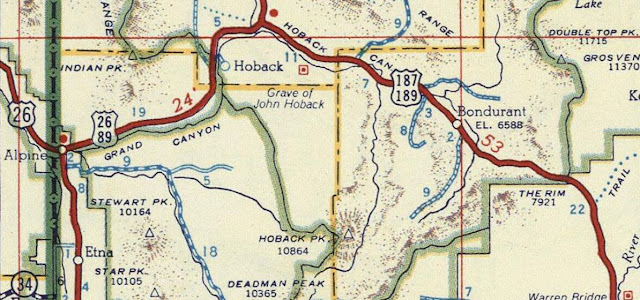John Hoback
 |
| Hoback Canyon's name dates back to 1811 when The Astorians passed through. |
We turn east at Hoback Junction. At one time, US 89 actually followed the Hoback River to get to Jackson. That's back when engineers didn't have the heavy equipment and technical capabilities to tame the Snake River Canyon. There's a real nice highway through Hoback Canyon.
Interestingly, it received it's name as a result of the Wilson Price Hunt Expedition of 1811. The members of that expedition were called "The Astorians" and we just finished a gripping, dramatic book detailing the group's perilous travels through the area. John Hoback helped guide The Astorians and that's how Hoback got its name. Supposedly, Hoback's grave is located in the vicinity. If possible we will try to find it.We will be camped our first night at Hoback Campground. Even though the Forest Service will have closed the campground on September 30, they don't lock it up like they do the campgrounds in Snake River Campground. So we will get to stay there for free. That "might" give us enough time to visit Hoback's grave....IF his grave actually exists.
It's VERY unlikely that the actual John Hoback is buried any where near the river and canyon that bear his name. He was killed in 1813 by Natives at a location hundreds of miles away. Even back then his remains were untended and it's impossibly unlikely Hoback's remains were found and reinterred. Nope. It's much more likely that makers of this 1956 Shell highway map simply misunderstood an early wooden interpretive sign located in Hoback Canyon.
No one will ever know for sure but one report indicates John Hoback was born in 1745. He somehow fell in with a bunch of frontier trappers who went west not long after Lewis & Clark returned. The rag tag trappers surfed ashore at what's now Three Forks, Montana, a point considered the birthplace of the Missouri River. The Blackfeet Indians tried to wipe out the trappers and killed many of them. Hoback and some other joined up with Andrew Henry and retreated across he Continental Divide to spend the winter near present day St. Anthony, Idaho, on a river that now carries Henry's name. In the spring, Hoback and two pals set out to return "back east". They gave Blackfeet Country a wide berth before beginning to canoe down the Missouri River. On May 26, 1811, they crossed paths with William Price Hunt's expedition and quickly decided to join Hunt's journey. Hoback and his buddies gave impassioned reasons why Hunt should abandon Lewis & Clark's route and travel overland far south of Blackfeet Country. That's the gist of how Hunt's Astorians would up on what's now the Hoback River. By the time Hunt's entourage made it to Hoback Canyon, John Hoback has been with the group almsot exactly five months. Eventually Hoback, et al, led Hunt's crowd up and over Teton Pass to make their way to the Henry's Fork. There they build log canoes and set forth downriver to join The Snake near Menan Buttes. Hunt's group passed through Idaho Falls that fall. The remainder of Hunt's ill-fated journey to the Pacific Ocean is an epic saga you need to read to believe. It's VERY unlikely that the actual John Hoback is buried any where near the river and canyon that bear his name. He was killed in 1813 by Natives at a location hundreds of miles away. Even back then his remains were untended and it's impossibly unlikely Hoback's remains were found and reinterred. Nope. It's much more likely that makers of this 1956 Shell highway map simply misunderstood an early wooden interpretive sign located in Hoback Canyon.
After leaving Hunt's group, Hoback and many men of a similar trapping persuasion set up shop over in Oregon where they were all killed by the local Natives. That is a story far too long to tell here. In any event, Hoback is given credit as being a guide to Hunt's group but it's quite likely he shared that duty with his pals, Jacob Rezner and Edward Robinson. It will forever remain unclear why Hoback's name was used for various landmarks while Rezner and Robinson's names weren't.
In any event, traveling Hoback Canyon is an awesome way to recall the lives and times of early trappers as well as the truly mind-boggling William Price Hunt Expedition.
See:
https://www.findagrave.com/memorial/148154836/john-valentine-hoback




Comments
Post a Comment